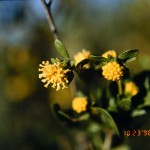Tarbush, Blackbrush
Flourensia cernua DC.
Asteraceae (Sunflower Family)
Description
Tarbush is a strongly aromatic (tarry odor) perennial shrub of the Sunflower (Asteraceae) family. It grows from a network of shallow roots that can extend four meters. It also has a few deep tap roots enabling it to exploit deep soil waters as well as shallow surface water. This allows it to survive in the Chihuahuan desert where it is primarily found. Its stems are brittle and have a characteristic black color. Tarbush is much-branched with many oblique branches off its base and densely leafy. The plant's height may vary from 1 ft or 30 cm tall on dry sites to more than 6 ft or 180 cm tall in deep, overflow areas. Its leaves may persist into winter making it a semi-evergreen. The alternate leaves of Tarbush are thick, elliptical to ovate, up to 25 by 15 mm, and smooth (sometimes undulate) along the edges. The dense leafage is sticky and resinous with a faint odor of tar. The yellow flowers are solitary in the leaf axils (the angle between the upper leaf and the leaf stem), forming a leafy flowering stem in the fall. There are no ray flowers, about 10-25 disk flowers with a 3-4 mm corolla, and an involucre which is bell-shaped and has three series of overlapping phyllaries. The flowers are drooping and tend to bloom from September to December. The forage value of Tarbush is poor for livestock and wildlife. Livestock generally avoid it.Habitat
Tarbush is common on dry plains, hills, and mesas from counties just east of the Pecos River in Texas, west to Arizona, and south to Mexico. It is most common on alluvial soil derived from limestone and needs full sun. Where it is found in the desert it co-dominates with Creosote (Larrea tridentata) and acacia species. It often is the only shrub in a grassland. Recently, it has increased in abundance due to over-grazing of the grasses.Toxic Agent
(Much of the following information was referenced from Poisonous Plants of the United States and Canada by John M. Kingsbury.) Tarbush may poison sheep, goats, and cattle. The toxin in Tarbush is unknown. In experiments, sheep and goats were force-fed Tarbush fruits, which were lethal at about 1 percent of the animal's weight. Individual susceptibility varied considerably, and the difference between toxic and lethal doses was small. In moderate amounts, the foliage was not toxic.Signs of Livestock Ingestion
On the range, clinical signs appear a day or less after an animal eats a toxic amount of the plant. Depending on the amount ingested, death may follow within 24 to 72 hours, or occasionally longer. Some animals recover rapidly after showing clinical signs for several days to a week. Signs are modified somewhat by the severity of poisoning, but generally consist of: Loss of appetite; Abdominal pain; Reluctance to move; Occasional respiratory distress. Acute cases may salivate profusely. Animals generally remain on their feet until shortly before dying without struggle. Poisonings occur mostly in January through March after the fruit has matured but before it falls.Management Strategies
Tarbush is extremely unpalatable and is grazed only if animals are starving or have severe phosphorus deficiencies. Avoid overgrazing and use proper supplemental feeding programs (including phosphorus). Spike 20P® controls Tarbush on a large-broadcast basis. For aerial or ground broadcast applications, apply Spike 20P® at 0.75 to 1 pound a.i./acre (3.75 to 5 pounds of pellets). Follow herbicide treatments with proper stocking rates and good grazing management practices.Images
Plant Characteristics
Flower Color: Yellow
Seed Type: Achene
Duration: Perennial
Stem Texture: Hairless/Smooth
Growth Habit: Shrub (Woody)
Leaf Shape
 : Simple with Pinnate or Parallel Venation
: Simple with Pinnate or Parallel Venation
Season: Warm
Distribution
 : 07 - Edwards Plateau, 08 - Rolling Plains, 09 - High Plains, 10 - Trans-Pecos
: 07 - Edwards Plateau, 08 - Rolling Plains, 09 - High Plains, 10 - Trans-Pecos
Distributions
Distribution refers to the ecological region in Texas that a plant has been found. You can also view a clickable map.
Book: Brush and Weeds of Texas Rangelands (B-6208), Toxic Plants of Texas (B-6105)
Collection: Brush and Weeds, Toxics
Livestock Affected: Cattle, Goats, Sheep
Livestock Signs: Abdominal Pain, Anorexia, Colic, Excess Salivation, Irregular Breathing






